Feature: Australia Alters Course On ANZAC Spirit
Scoop Feature: Australia Alters Course On ANZAC Spirit
By Selwyn Manning – Scoop Co-Editor.
Ninety years to the day after New Zealand and Australian soldiers stormed the beaches at Gallipoli, Australia’s Prime Minister John Howard displayed intent to abandon nine decades of ANZAC spirit. Howard’s decision to abandon plans to attend the New Zealand ceremony at Chunuk Bair was a boycott. Context justifies the assertion.
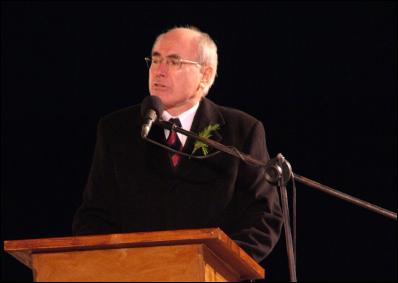
What really was Australian PM John Howard’s message and to whom was it intended?
For over one month prior to Anzac Day New Zealand and Australian foreign affairs officials exchanged emails and calls seeking to resolve John Howard’s insistence that he would not be attending the Chunuk Bair service.
A compromise was sought – the itinerary staggered to ensure time and opportunity was assured. Unlike former commemorations where services ran at the same time, the 90th anniversary services would be staggered so as to allow for all leaders – Prince Charles, Helen Clark, and John Howard to attend the dawn service, the Australian service at Lone Pine, and the kiwi service at Chunuk Bair.
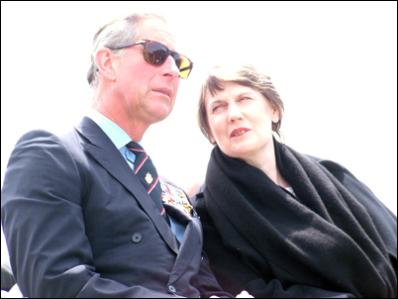
Scoop Image: Lone Pair – Prince Charles and Helen Clark snubbed by John Howard at Chunuk Bair.
John Howard was not convinced. He chose instead to attend a barbeque on the beach at ANZAC Cove.
New Zealand foreign affairs contacts say their Australian counterparts were sympathetic to the kiwi position – that Howard’s boycott would be seen as an insult by New Zealanders and that the issue would be certain to attract intense media examination. Once the caution was issued, it had to be fulfilled.
Certainly the question was not whether Howard’s actions ought to cause offence but rather what had compelled Howard to deliver his message without regard and in a no-holds-barred manner. Was it personal? One remembers how Howard left Helen Clark stranded and without support, surrounded by industrial action and played like a chess piece at an Australian airport. Foreign affairs contacts say the snub was not personal but rather an example of a deeply help contemporary Australian belief that ANZAC Day is for Australians. There is a wider precedence. Australia has been expanding its brand of advance Australia fair across the Pacific region. It is a fallacy for New Zealanders to see ourselves as equals in the Australasian association. In foreign affairs terms New Zealand stands alone, is more liberalist, but is in reality cautious to be at odds with Australia on policy grounds.
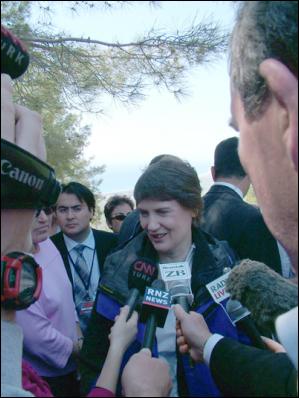
Scoop Image: As battleships gathered in the Aegean Sea a media scrum formed around Helen Clark.
When considering Howard’s snub over Chunuk Bair, Helen Clark was verbally guarded. But if body language was an indicator the kiwi PM was livid. Outwardly awkward she answered reporter questions simply with a: ‘the decision rests with Mr Howard’ line. Journalists interpreted this as the Prime Minister letting the snub issue run while minimising any chance of a trans-Tasman rift. Indeed the issue ran. News broke in New Zealand first via Barry Soper reporting for NewstalkZB, followed by Scoop and TV3. Strangely, the Sunday Star Times had first opportunity to run the story but apparently failed to see the newsworthiness of highly regarded journalist Vernon Small’s account.
Two days later the Prime Minister’s Wellington-based press secretary got busy contacting news offices with a spin-line that there was no snub, that Howard’s non-attendance had not created a precedence as he had never before attended the Chunuk Bair ceremony. He said Helen Clark in turn had never before attended Australia’s Lone Pine service. All this was probably true, but for one difference: both Australian and New Zealand officials had created a precedence by ensuring both services were held this year at different times – this to allow dignitaries to attend both. Prince Charles and Helen Clark attended all services… John Howard did not.
Again, context is essential when unpicking the meaning of Howard’s actions.
Howard had earlier publicly slighted New Zealand (when it moved to advance a free trade agreement with China) saying Australia would be the first “fully” developed nation to secure a FTA with China. Earlier again, in 2003, Howard had secured himself Australia as the lead nation in the Pacific, successfully orchestrating administrative control of the Pacific Islands Forum and commanding implementation of security, policing, and financial governance controls over nations and states traditionally far from Australia’s reach and in many cases usually fostered by New Zealand.

Scoop Image: Chunuk Bair to ANZAC Cove.
The Australian PM’s boycott of Chunuk Bair was another demonstration of Australian nationalism – born of the ANZAC spirit but focussed on contemporary Australian values that disregard the sacrifice that New Zealand (then an infant nation) suffered 2721 deaths, 4852 casualties out of 8556 young men during that doomed battle at Gallipoli. Australia’s contemporary view of New Zealand, especially when considering things military, is that New Zealand sponges off Australia, does not pull its weight, is a combat liability, and at best, relegated to a logistics role.
That view was not accurate during World War I or World War II.
As one senior New Zealand military officer said: Howard’s snub was an “absolute disgrace”.
Howard’s preference to attend a barbeque rather than present a wreath to a solemn service at Chunuk Bair was about as brash and disregarding as could be imagined to the memory of those New Zealanders who died.
Just as Australia remembers the waste and needless sacrifice of its young men at Lone Pine, so does New Zealand commemorate Chunuk Bair –the high-water mark of kiwi endeavour and loss on the Gallipoli peninsula.
Mustafa Kemal Ataturk wrote in 1934: “Those heroes that shed their blood, and lost their lives… you are now lying in the soil of a friendly country. Therefore rest in peace. There is no difference between the Johnnies and the Mehmets to us where they lie side by side. Here in this country of ours… you, the mothers, who sent their sons from far away countries, wipe away your tears, your sons are now lying in our bosom, and are at peace. After having lost their lives on this land they have become our sons as well.”
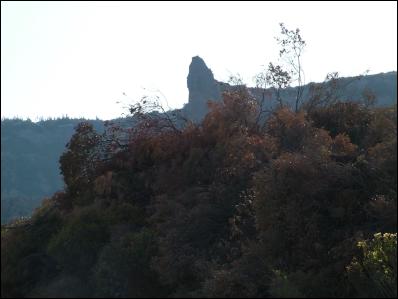
Scoop Image: The Sphinx looms high above ANZAC Cove.
Ataturk’s words challenge us all to consider the irrelevancy of divisions and borders particularly when reflecting on such an iconic event as ANZAC Day – a focal-point that has endured the passage of time.
For Australia, and certainly for New Zealand, ANZAC Day represents a significant event that offered, and offers, both countries a position from which to consider a pre and aft shift of cultural and national mood. Prior to ANZAC Day 1915 both nations offered subservient obedience toward the demands of imperial Britain. Once ANZAC Day was relegated to history, and over the decades as details emerged offering perspectives and dimension, Australia and New Zealand embarked on engineering a respective national identity (idiosyncratic in identifying the differences between the two nations, but with a common history) best expressed as the ANZAC spirit.
Both nations questioned the right of far off England to orchestrate foreign and defence policy demands. Australia for example pulled its troops out of Europe during World War II so as to protect itself from Japan – a danger that loomed on the Pacific front.
New Zealand ensured command over its troops were led by New Zealanders and not as had previously occurred surrendering the fate of its youth and young men to the irreverence of foreign-leaning generals. Indeed today, at ANZAC Cove, in the presence of the heir to the British throne, New Zealand’s chief of defence Bruce Ferguson reflected on the blind errors, led by militarist Britain, that resulted in the deaths of thousands of our young men.
But the shadow cast over ANZAC Day 2005 was born of today.
Australia’s ANZAC Day 2005 set a heading that displayed an altered course. This event of national identity was clearly but cleverly engineered to present to Australians (as opposed to New Zealanders) a flag-waving extravaganza of national pride. John Howard’s mood captured as much as presented a feeling within Australia that it ought to naturally assume its place on the podium of ANZAC history, a solitary place of choice, where New Zealand can make up the NZ in ANZAC but exalts a contemporary belief that New Zealand had never paid its way in battles throughout the 20th Century. If one looks at the numbers of the dead, and Australia appears to be considering it currency here, then New Zealand had little reason to feel “snubbed” at Chunuk Bair. Certainly one Australian journalist considered New Zealand’s sensitivity toward Howard’s snub ridiculous, a media beat up, and irrelevant – if New Zealand had boycotted the Australian service at Lone Pine Australians, she said, couldn’t give a damn.
Howard’s decision to attend a barbeque rather than lay a wreath of respect for the fallen New Zealanders at Chunuk Bair was a boycott and a snub. It rendered New Zealand as secondary, subservient, and in some aspects irrelevant. In his speech at ANZAC Cove, John Howard referred to New Zealand once – while dotting the word Australia at least 20 times in the course of his commemoration.
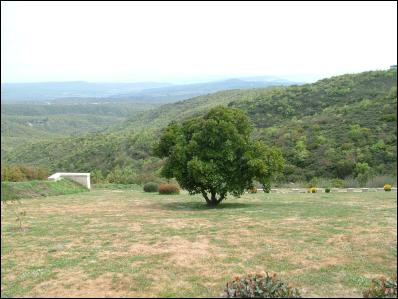
Scoop Image: The Australian Prime Minister’s decision to attend a barbeque rather than lay a wreath of respect for the fallen New Zealanders at Chunuk Bair was a boycott and a snub.
The question as to why Australia and New Zealand appear to celebrate ANZAC Day is a strange notion that was not lost on the Turks. Gallipoli after-all represents the worst of military expeditions: Australia, New Zealand and Britain were the invaders, the invading force was met by a determined and formidable defender, Britain’s Winston Churchill had arrogantly underestimated the abilities of the Turkish military. Australia lost 8709 young men, New Zealand 2721 young men, and Britain 22,000, France 10,000. Turkey lost over 87,000 people but ultimately drove the ANZACs back onto the beaches and out to sea.
Again, the key to deciphering this irony lies within and mood that eventually separated us from Britain. It was a defeat that offered both Australia and New Zealand a strange place from which to build a state of nationhood where we chose glory in favour of grief while reciting in remembrance that solemn warning Lest We Forget.
It could be argued that Ataturk’s famous words ought to challenge Australia and New Zealand to develop a national identity that embraces over exclusion the sacrifice of others. This significant ANZAC Day saw Turkey’s peoples receive the ANZACs with open arms. It would be fair to say the Turks have adopted the spirit of Ataturk’s proclamation with a sincerity that humbles those from Australia and New Zealand with a mood that cements ANZACs and Turks with a solemn reverence as equals. One young Turkish woman said: “Perhaps this day will mark the beginning of a friendship born of the errors of the past.”
Today, ANZAC Cove is cemented in the OE itinerary of Australasian youth. It was not lost on those observing there on April 25 2005 that the age of those attending the ANZAC Day services matched almost perfectly the ages of those who were slaughtered on that beach and surrounding hills we know as Gallipoli. It was not a boozy affair as some home-based media had reported. To the contrary, the young New Zealanders that gathered at Chunuk Bair sat in pose of honourable respect, they clapped when the first World War II veterans arrived, and they were moved by the moment when all shared a sorrow as a lone kiwi soldier performed a perfect rendition of the Last Post.
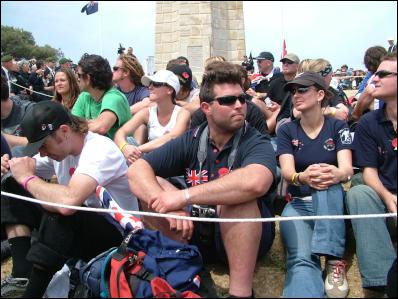
Scoop Image: The young New Zealanders that gathered at Chunuk Bair sat in pose of honourable respect, they clapped when the first World War II veterans arrived…
Cultural observers may wonder why it is so that young New Zealanders and Australians now flock to that place in their thousands, rather than in the past when it was feared that ANZAC remembrance would die with the last of the battle’s veterans. Perhaps it is because as baby-boomers we were accustomed to seeing the very aged and frail old soldiers of Gallipoli making their way slowly along the parade. Perhaps we saw this as an old person’s war and could not relate personally to the events of so long ago. Perhaps this youthful generation sees beyond that veil to the young men of their age who were swindled into believing values of ‘For God, For King and For Country’ and who were used as cannon-fodder for an imperialist advance blindly set on securing a geo-political advantage – beyond all costs.
There, at Chunuk Bair, the events of 90 years ago found shape in a palpable surreal space that cast irrelevance over an issue so brash and crude as a snub by a contemporary politician.
Chunuk Bair remains New Zealand’s icon, as does ANZAC Cove, just as Lone Pine is an icon for Australia – and yes in Turkey, 90 years after the fact, we did remember them.
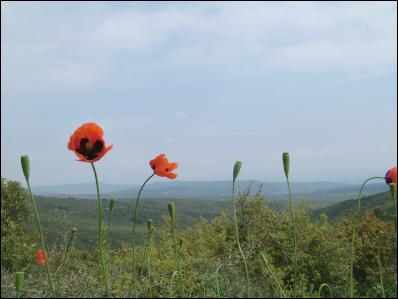
Scoop Image: poppies grow wild on the peaceful hills of Gallipoli.
ENDS


 Richard S. Ehrlich: Deadly Border Feud Between Thailand & Cambodia
Richard S. Ehrlich: Deadly Border Feud Between Thailand & Cambodia Gordon Campbell: On Free Speech And Anti-Semitism
Gordon Campbell: On Free Speech And Anti-Semitism Ian Powell: The Disgrace Of The Hospice Care Funding Scandal
Ian Powell: The Disgrace Of The Hospice Care Funding Scandal Binoy Kampmark: Catching Israel Out - Gaza And The Madleen “Selfie” Protest
Binoy Kampmark: Catching Israel Out - Gaza And The Madleen “Selfie” Protest Ramzy Baroud: Gaza's 'Humanitarian' Façade - A Deceptive Ploy Unravels
Ramzy Baroud: Gaza's 'Humanitarian' Façade - A Deceptive Ploy Unravels Keith Rankin: Remembering New Zealand's Missing Tragedy
Keith Rankin: Remembering New Zealand's Missing Tragedy